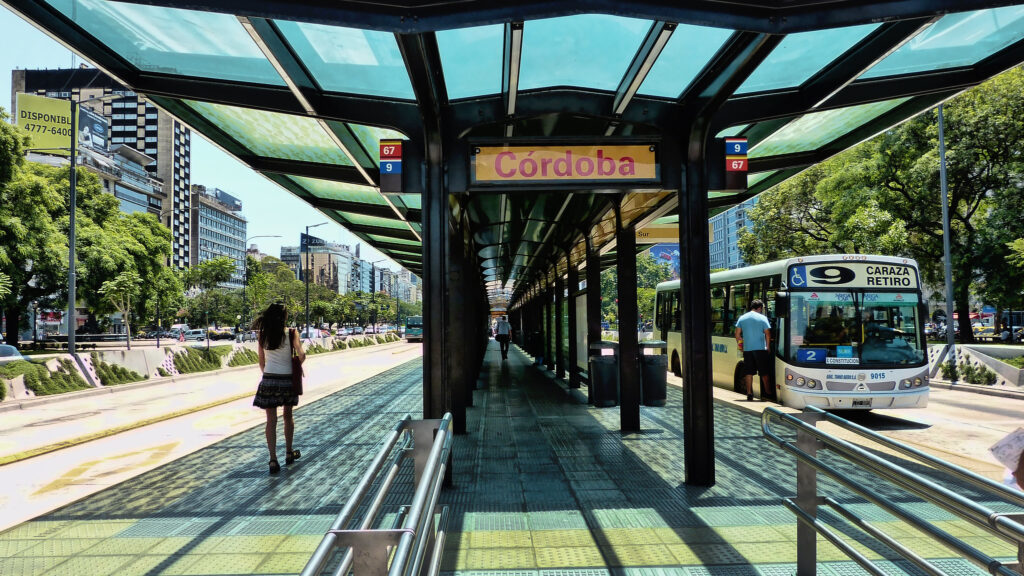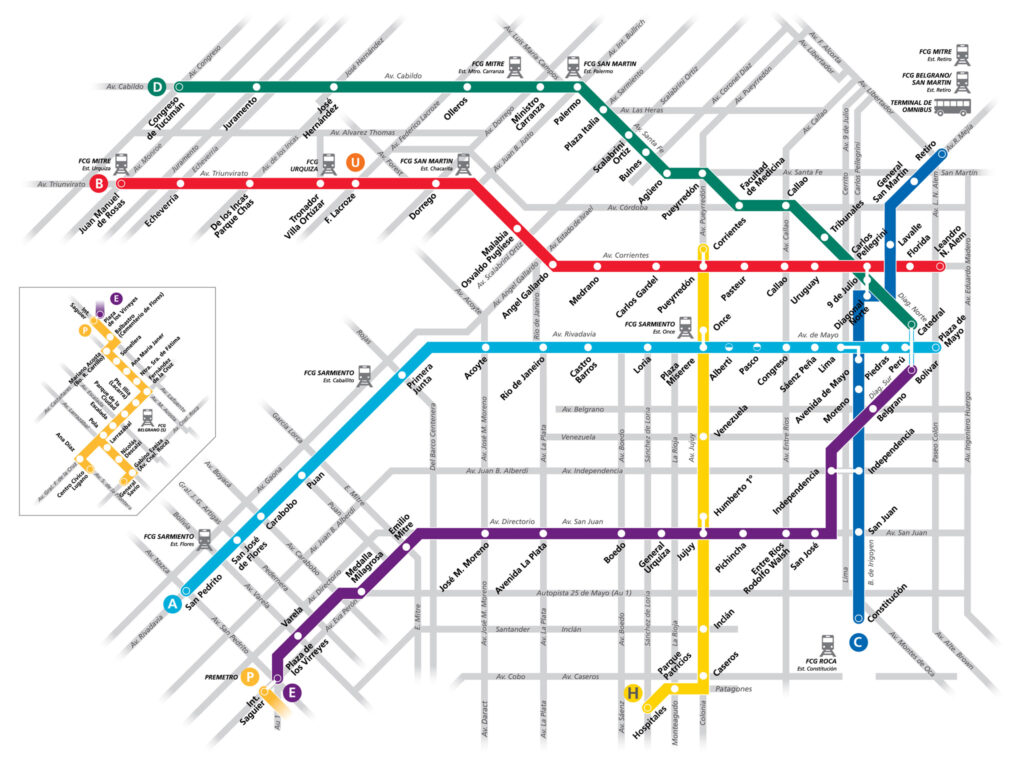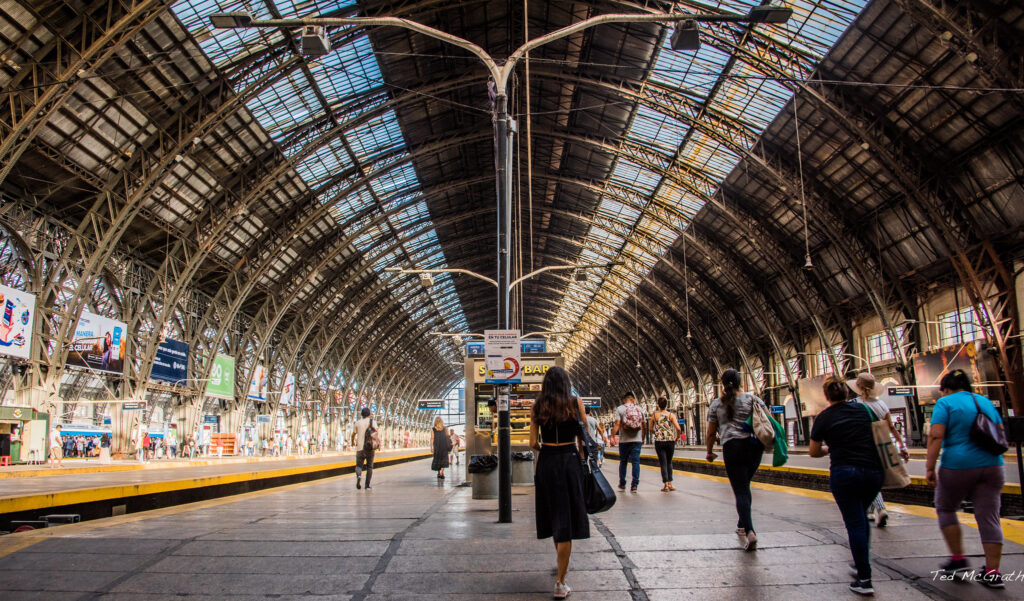Are you a digital nomad, traveler, or expat pondering the best ways to navigate the vibrant streets of Buenos Aires? Whether you’re planning a short visit or considering a longer stay, understanding the ins and outs of local transportation is essential.
ExpatPathways brings you an essential guide to transportation in Buenos Aires, covering everything from bustling buses and the historic subway system to the modern convenience of ride-hailing apps and the eco-friendly choice of bicycles.
This article is your go-to resource for getting around the city efficiently, offering insights into the most practical and enjoyable transportation options. Join us as we delve into the best ways to explore the Argentine capital, ensuring your journey is as smooth and enjoyable as possible.
The Best Transportation Options in Buenos Aires
Buses in Buenos Aires
Buenos Aires, a vibrant and lively city, offers a variety of transportation options for its residents and visitors. Among these options, the bus, locally known as “colectivo,” stands out for its accessibility and coverage. In this article, we will delve into the details of how this essential transportation system operates in the Argentine capital.
The Bus Network
The city of Buenos Aires boasts an extensive network of approximately 400 bus lines that cover the entire metropolitan area. This system is characterized by its economic accessibility and dynamism, making it the preferred choice for moving from one point to another in the city.
Identification and Payment
Each bus line is identified by a unique number and operated by different companies. To use this service, passengers must pay the fare using the SUBE card, a rechargeable card system that can be topped up at ticket offices, kiosks, or even from a cellphone, thus facilitating access to public transport.

How to Travel by Bus
Buses follow predetermined routes, stopping at specified stations or stops. To board, passengers need to signal to the driver from the corresponding stop.
When wishing to get off, it is necessary to notify the driver by pressing a bell located near the descent doors, which are situated in the middle and at the back of the vehicle.
Buses in Buenos Aires are designed to be in constant operation, running 24 hours a day with a reduced frequency after 10 PM, but ensuring a minimum service every 30 minutes. This commitment to continuous service reflects the importance of the bus in the daily life of the city.
Distinctive Features
Buses are not only recognizable by their unique numbers but also by the distinctive colors of each line.
These vehicles are equipped to facilitate both boarding through the front door and alighting through the rear or central doors.
Stops are clearly marked with signs indicating the line number and a summary of its main route.
Popularly called “bondi” in the local slang, buses are a fundamental part of Buenos Aires’ transportation mosaic, standing out for their omnipresence and ability to efficiently and economically connect different points of the city.
Plan your journey by public transport
The subway in Buenos Aires
The Buenos Aires subway holds the distinction of being the first underground transportation system in Latin America, the Southern Hemisphere, and the Spanish-speaking world.
Historical Overview
Since its inception in 1913, the Buenos Aires subway system has expanded from its initial network connecting Plaza de Mayo with Plaza Miserere (Once).
Today, the system comprises six lines, identified as A, B, C, D, E, and H, along with the Premetro, a tram line that integrates with the subway system. Future expansions include the planned lines G, F, and I.

The Network
The subway network boasts a total of 90 operational underground stations, which extends to 108 when including the Premetro stations. The system spans approximately 54.7 km (about 34 miles) of commercial service tracks and 62.8 km (about 39 miles) when including depots and workshops.
Remarkably, the entire network is subterranean, without any sections at grade or on viaducts. However, it’s not a closed system; there are two ramps connecting Line A with the Sarmiento Railway and Line B with the General Urquiza Railway.

Color Coding and Operation
In the 1970s, the then-operator, Subterráneos de Buenos Aires, assigned a color to each line: Line A to light blue, B to green, C to violet, D to red, and E to yellow.
In the mid-1990s, the current operator, Metrovías, decided to change this scheme, resulting in Line B being associated with red, Line D with green, Line C with blue, and Line E with violet, while the new Line H was identified with yellow.
Station Features
Subway stations vary, with some featuring central platforms flanked by tracks for both directions, while others have a specific platform for each direction. This system provides an efficient means of transport, enabling quick movement across the city without the hassle of traffic congestion.
Check Buenos Aires subway schedules here
The subway operates until 11 PM on average, depending on the line and day, with service starting at 5:30 AM on weekdays, 6 AM on Saturdays, and 8 AM on Sundays and holidays.
Payment
Fares for the subway are paid using the SUBE card, a rechargeable card that can be topped up at ticket offices, kiosks, or via a cellphone, simplifying access to Buenos Aires’ public transport.
Railways in Buenos Aires
The train system in Buenos Aires spans a vast area of the Buenos Aires Metropolitan Area, enabling long-distance travel not only within the City of Buenos Aires but also to and from the Province of Buenos Aires, whether north, south, or west.
The Network
The metropolitan railways of Buenos Aires form an extensive network consisting of seven suburban train lines, six subway lines, and one light rail line serving the Buenos Aires Metropolitan Area (AMBA).
The subway extends 54.7 km, the electric railways cover 278 km, while the remainder of the network comprises diesel traction branches, totaling approximately 1,000 km. This makes it one of the largest urban service networks in the world.

Usage and Capacity
Annually, around 1 billion passengers utilize the railway service, which features a total of 305 stations.
The railway network in the Autonomous City of Buenos Aires and its metropolitan area ranks among the largest metropolitan train networks globally.
Metropolitan Railways
These so-called metropolitan railways branch out from the Autonomous City of Buenos Aires to the entire Buenos Aires Metropolitan Area (AMBA). There are 6 railway nodes from which the various lines operate:
- Retiro: This node is the starting point for the Mitre, Belgrano Norte, and San Martín lines. It is divided into three adjacent terminal stations.
- Constitución: The starting point for the General Roca line.
- Once: The starting point for the Sarmiento line.
- Lacroze: The starting point for the Urquiza line.
- Sáenz: The starting point for the branches of the Belgrano Sur line.
Check the Buenos Aires railway map here
Payment
Fares for the train are paid using the SUBE card, a rechargeable card that can be topped up at ticket offices, kiosks, or via a cellphone, facilitating access to public transport across Buenos Aires.
Check Buenos Aires railway schedules here
Taxis in Buenos Aires
The taxi fleet in Buenos Aires is an iconic aspect of the city and one of the largest and most efficient in the region.

Quick and Convenient Option
Taxis offer a comfortable and fast way to get around the city, especially at night when bus traffic diminishes, and the subway is no longer an option.
Approximately 30,000 taxis roam the streets of Buenos Aires, providing the advantage of transporting passengers to any desired point in the city.
Taxis operate on a meter system, which includes a base fare upon entering the vehicle and a fixed rate for every 200 meters traveled.
Official app “BA Taxi” of the government of the City of Buenos Aires
Night Fare
At night, specifically between 10 PM and 6 AM, fares increase by 20%.
Payment Methods
Traditionally, taxis have only accepted cash payments, but there’s a gradual shift towards electronic payment systems, including virtual wallets or POS systems, although this is not yet widespread.
Recommendations for Taking a Taxi
- Choose Radio Taxi Companies: It’s advisable to only take taxis that belong to radio taxi companies. These taxis display the license number on the doors and usually have an identification, typically on the roof, indicating the radio taxi company they belong to.
- Check the Taxi’s License and Driver’s Permit: Ensure that the taxi’s license and the driver’s driving permit are displayed inside the taxi.
- Ensure the Meter is Activated: Verify that the driver activates the fare system (the meter) as the journey begins, not before or after, to prevent arbitrary charging.
- Booking Options: Many radio taxi companies offer the option to request a taxi via an app or phone call, which is ideal for avoiding unsafe areas and traveling during late hours.
Radio taxi companies in Buenos Aires
- RadioTu Taxi – 011 3862-2222
- Taxi Onda Verde – 011 4867-0000
- Radio Taxi Buen Viaje – 011 5252-9999
- Taxi Premium – 5238-0000
- Radio Taxi Del Plata – 011 4505-1111
Ride-Hailing Apps in Buenos Aires
In recent years, traditional taxis and remises (private cars) have seen their dominance challenged by the rise of ride-hailing apps in Buenos Aires.
A Convenient and Competitive Option
The convenience of summoning a vehicle from any smartphone at any time of day, coupled with more competitive pricing, has made ride-hailing apps a noteworthy option for those looking to navigate the city of Buenos Aires.
Whether you’re visiting or living in Buenos Aires, there are several well-known ride-hailing apps available that accommodate various payment methods, including cash, virtual wallets, credit cards, and in some cases, PayPal.
Popular Ride-Hailing Apps
In Argentina, particularly in Buenos Aires, DiDi, Cabify, and Uber emerge as the most popular ride-hailing apps.
They offer different travel modes and services, as well as fare estimates, providing a flexible and efficient means of transportation suited to a range of needs and preferences.
Cycle paths in Buenos Aires
In July 2009, the construction began on what is now the City’s Network of Protected Bike Lanes and Cycle Paths, which today extends to 300 kilometers. At that time, only 0.4% of trips were made by bicycle, and today they account for 7%.
More than 400,000 trips a day are made by people of all ages cycling to study, work, or for recreation, and every year they benefit from more safe infrastructure connecting them from their starting point to their destination.
The Network of Protected Bike Lanes
The network of protected bike lanes consists of exclusive lanes for bicycles, shielded from the rest of vehicular traffic by a physical separator, connecting the main transit hubs of the City.
These bike lanes are generally located on the left side of the street and have two-way traffic. They are also equipped with vertical, horizontal, and tactile signage, or physical interventions on the pavement, to reduce speed.
Check here map of the protected bike lanes of Buenos Aires
Bicycle Parking
Buenos Aires offers more than 5,000 spaces for bicycle parking, located near subway entrances, public buildings, community centers, hospitals, schools, shopping centers, parks, squares, and more.
However, it is advisable to avoid parking bicycles in public spaces for security reasons, especially when they are not within reach or sight of their owners.
Signage and Reliability
A significant portion of Buenos Aires’ bike lanes comes with corresponding signage, including traffic lights and designated lanes.
Cycling has become a very reliable option for getting around the City of Buenos Aires, especially during peak hours when vehicle traffic and public transport can clog the city’s main arteries.
Ecobici System
An important feature of Buenos Aires is the Ecobici system, which offers bicycle rental with prior registration and app download.
Through QR code unlocking, you can approach any of the bicycle stations located at various points in the city, ride a bicycle, and then dock it at another station within a 30-minute timeframe.
Final considerations
As we conclude our journey through the diverse transportation options of Buenos Aires, it’s clear that whether you’re a digital nomad in search of connectivity, a traveler eager to soak in every moment, or an expat weaving into the fabric of this vibrant city, Buenos Aires offers a transit solution tailored to your needs.
ExpatPathways has guided you through the labyrinth of colectivos, subterráneos, trains, taxis, ride-hailing apps, and bicycles, highlighting the efficiency, convenience, and charm of each mode of transport.
Embrace these pathways to discover the true essence of Buenos Aires, where every journey promises new adventures and stories waiting to unfold.
Remember, the city’s heartbeat is best felt through its streets and transit routes, making your travel experience uniquely enriching and deeply personal. With this guide, navigating Buenos Aires becomes not just a necessity but an integral part of your exhilarating adventure in Argentina.
(Featured Image Source: MMC/manelo/flickr.com)


